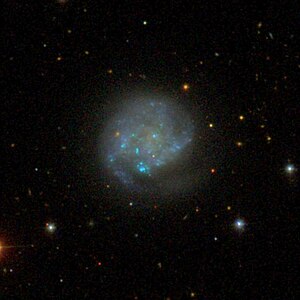NGC 4299
| Galaxy NGC 4299 |
|
|---|---|

|
|
| SDSS recording | |
| AladinLite | |
| Constellation | Virgin |
|
Position equinox : J2000.0 , epoch : J2000.0 |
|
| Right ascension | 12 h 21 m 40.5 s |
| declination | + 11 ° 30 ′ 00 ″ |
| Appearance | |
| Morphological type | SAB (s) dm: / HII |
| Brightness (visual) | 12.3 mag |
| Brightness (B-band) | 12.9 mag |
| Angular expansion | 1.7 '× 1.6' |
| Position angle | 26 ° |
| Surface brightness | 13.2 mag / arcmin² |
| Physical data | |
| Affiliation | Virgo cluster |
| Redshift | 0.000791 ± 0.000007 |
| Radial velocity | 237 ± 2 km / s |
|
Stroke distance v rad / H 0 |
(8 ± 1) x 10 6 ly (2.42 ± 0.17) Mpc |
| history | |
| discovery | William Herschel |
| Discovery date | March 15, 1784 |
| Catalog names | |
| NGC 4299 • UGC 7414 • PGC 39968 • CGCG 070-025 • MCG + 02-32-010 • IRAS 12191 + 1146 • 2MASX J12214230 + 1130118 • VCC 491 • GC 2875 • H II 62 • h 1200 • HOLM 376B • VPC 149 | |
NGC 4299 is a spiral dwarf galaxy with extensive star formation regions of the Hubble type SBd in the constellation Virgo in the northern sky . It is estimated to be 8 million light years from the Milky Way and has a diameter of about> 10,000 ly. It is likely to form an interacting pair with NGC 4294 . It is listed as a member of the Virgo galaxy cluster under catalog number VCC 491 .
The galaxies IC 3173 , IC 3192 , IC 3196 , IC 3209 are in the same area of the sky .
The object was discovered on March 15, 1784 by the astronomer Wilhelm Herschel .
Web links
Commons : NGC 4299 - collection of images, videos, and audio files
